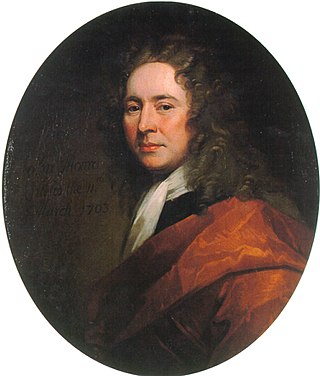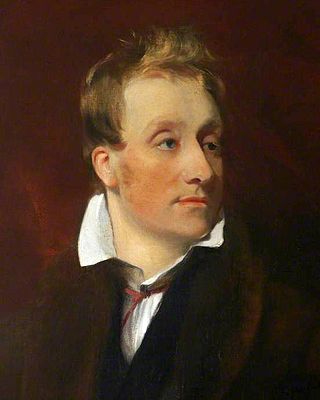
The Royal College of Surgeons of Edinburgh (RCSEd) is a professional organisation of surgeons. The College has seven active faculties, covering a broad spectrum of surgical, dental, and other medical practices. Its main campus is located on Nicolson Street, Edinburgh, within the Surgeons' Hall, designed by William Henry Playfair, and adjoining buildings. The main campus includes a skills laboratory, the Surgeons' Hall Museums, a medical and surgical library, and a hotel. A second office was opened in Birmingham (UK) in 2014 and an international office opened in Kuala Lumpur, Malaysia, in 2018.

John Monro of Bearcrofts (1670–1740) was a Scottish surgeon who was the progenitor of the Monro dynasty of anatomists in Edinburgh. He is credited with conceiving and playing a major role in founding the University of Edinburgh Medical School. He served as Deacon (President) of the Incorporation of Surgeons of Edinburgh.

Surgeons' Hall in Edinburgh, Scotland, is the headquarters of the Royal College of Surgeons of Edinburgh (RCSEd). It houses the Surgeons' Hall Museum, and the library and archive of the RCSEd. The present Surgeons' Hall was designed by William Henry Playfair and completed in 1832, and is a category A listed building.

Dr James Wardrop or Wardrope FRSE FRCSEd FRCS (1782–1869) was a Scottish surgeon and ophthalmologist.

Greyfriars Kirkyard is the graveyard surrounding Greyfriars Kirk in Edinburgh, Scotland. It is located at the southern edge of the Old Town, adjacent to George Heriot's School. Burials have been taking place since the late 16th century, and a number of notable Edinburgh residents are interred at Greyfriars. The Kirkyard is operated by City of Edinburgh Council in liaison with a charitable trust, which is linked to but separate from the church. The Kirkyard and its monuments are protected as a category A listed building.

Sir Harold Jalland Stiles was an English surgeon who was known for his research into cancer and tuberculosis and for treatment of nerve injuries.

Gilbert Primrose was a Scottish surgeon who became Surgeon to King James VI of Scots and moved with the court to London as Serjeant-Surgeon to King James VI and I on the Union of the Crowns. He was Deacon of the Incorporation of Surgeons and Barbers of Edinburgh on three occasions.

James Russell FRSE RSA (1754–1836) was a Scottish surgeon who was the first professor of clinical surgery at the University of Edinburgh. He was president of the Royal College of Surgeons of Edinburgh and was a co-founder of the Royal Society of Edinburgh. In 1805 he published one of the earliest descriptions of direct inguinal hernia. His collection of anatomical specimens was donated to the Surgeon's Hall in Edinburgh and is now known as the James Russell Collection.
Alexander Pennycuik (or Pennecuick) (1605-1695) was a Scottish military surgeon who became Surgeon General of the Scots forces in Ireland during the English Civil War. He was elected Deacon (President) of the Incorporation of Surgeons and Barbers of Edinburgh
Christopher Irvine of Bonshaw was a Scottish physician and surgeon who was the first medically qualified member of the Incorporation of Surgeons and Barbers of Edinburgh. A prolific author, he became historiographer to King Charles II and to King James II and VII.
John Naysmith (or Naismyth or Nasmyth) (1556 – 16 September 1613) was a Scottish surgeon who became surgeon to King James VI of Scotland and was appointed Royal Herbalist in London when the monarch became King James VI and I at the Union of the Crowns. He was Deacon (President) of the Incorporation of Surgeons and Barbers of Edinburgh.

William Borthwick of Pilmuir (1641-1689) was a Scottish surgeon who, having studied at Leiden and Padua, was the first to bring an international perspective to the Incorporation of Surgeons of Edinburgh. He served as Deacon (President) of the Incorporation from 1675-1677 and again from 1681-1683.
Alexander Monteith of Auldcathie (1660-1713) was an Edinburgh surgeon, who in his three terms as deacon (president) of the Incorporation of Surgeons of Edinburgh, presided over some of the most important changes in its history. These included obtaining the rights to perform anatomical dissection on the bodies of prisoners dying in jail, the granting of a royal charter by William and Mary in 1695, and the construction of the original Surgeons' Hall, the first permanent home of the Edinburgh Surgeons.

Adam Drummond of Binend (1679-1758) was a Scottish surgeon-apothecary who was appointed, jointly, as the first Professor of Anatomy at the University of Edinburgh.

Alexander Miles MD, LL.D, FRCSEd was a Scottish surgeon who worked at the Royal Infirmary of Edinburgh. He was known for the quality of his surgical teaching, for his role as a medical journal editor and as the author of popular surgical textbooks and books on surgical history. He was elected President of the Royal College of Surgeons of Edinburgh.
Forrest Dewar FRCSEd (1748–1817) was an 18th/19th century Scottish surgeon who served as President of the Royal College of Surgeons of Edinburgh for the period 1786 to 1788.

Robert Traill of Greyfriars was born at Denino, in 1603. He was son of Colonel James Traill, of Killcleary, Ireland, Gentleman of the Privy Chamber to Henry, Prince of Wales, and grandson of the Laird of Blebo, and Matilda Melvill of Carnbee. He graduated with an M.A. from St Andrews on 21 July 1621. he went over to Paris, and subsequently joined his brother in Orleans. He later studied at the Protestant College of Saumur. He was an English tutor in France to the sister of the Duke of Rohan in 1628. He was afterwards teacher in a school established by a Protestant minister at Montague, in Bus Poitou. He became chaplain to Archibald, Marquess of Argyll. In 1630 he returned to Scotland.
John Henry WishartFRCSEdFRSE was a Scottish surgeon who worked at the Royal Infirmary of Edinburgh. Although a general surgeon, he developed a special interest in the diagnosis and treatment of eye disease. He translated into English three major works of the Italian anatomist and surgeon Antonio Scarpa. With John Argyll Robertson, Wishart jointly founded the Edinburgh Eye Dispensary. He was surgeon in Scotland to King George IV and served as President of the Royal College of Surgeons of Edinburgh from 1820 to 1822.
Extramural medical education in Edinburgh began over 200 years before the university medical faculty was founded in 1726 and extramural teaching continued thereafter for a further 200 years. Extramural is academic education which is conducted outside a university. In the early 16th century it was under the auspices of the Incorporation of Surgeons of Edinburgh (RCSEd) and continued after the Faculty of Medicine was established by the University of Edinburgh in 1726. Throughout the late 18th and 19th centuries the demand for extramural medical teaching increased as Edinburgh's reputation as a centre for medical education grew. Instruction was carried out by individual teachers, by groups of teachers and, by the end of the 19th century, by private medical schools in the city. Together these comprised the Edinburgh Extramural School of Medicine. From 1896 many of the schools were incorporated into the Medical School of the Royal Colleges of Edinburgh under the aegis of the RCSEd and the Royal College of Physicians of Edinburgh (RCPE) and based at Surgeons' Hall. Extramural undergraduate medical education in Edinburgh stopped in 1948 with the closure of the Royal Colleges' Medical School following the Goodenough Report which recommended that all undergraduate medical education in the UK should be carried out by universities.
George Lauder, was an Edinburgh surgeon who was deacon (president) of the Incorporation of Surgeons of Edinburgh in 1744. During the Jacobite rising of 1745-46 he cared for the wounded after the Battle of Prestonpans, acted as surgeon with the Jacobite army on its march into England and retreat to Scotland, where he cared for wounded after the Battle of Falkirk.













